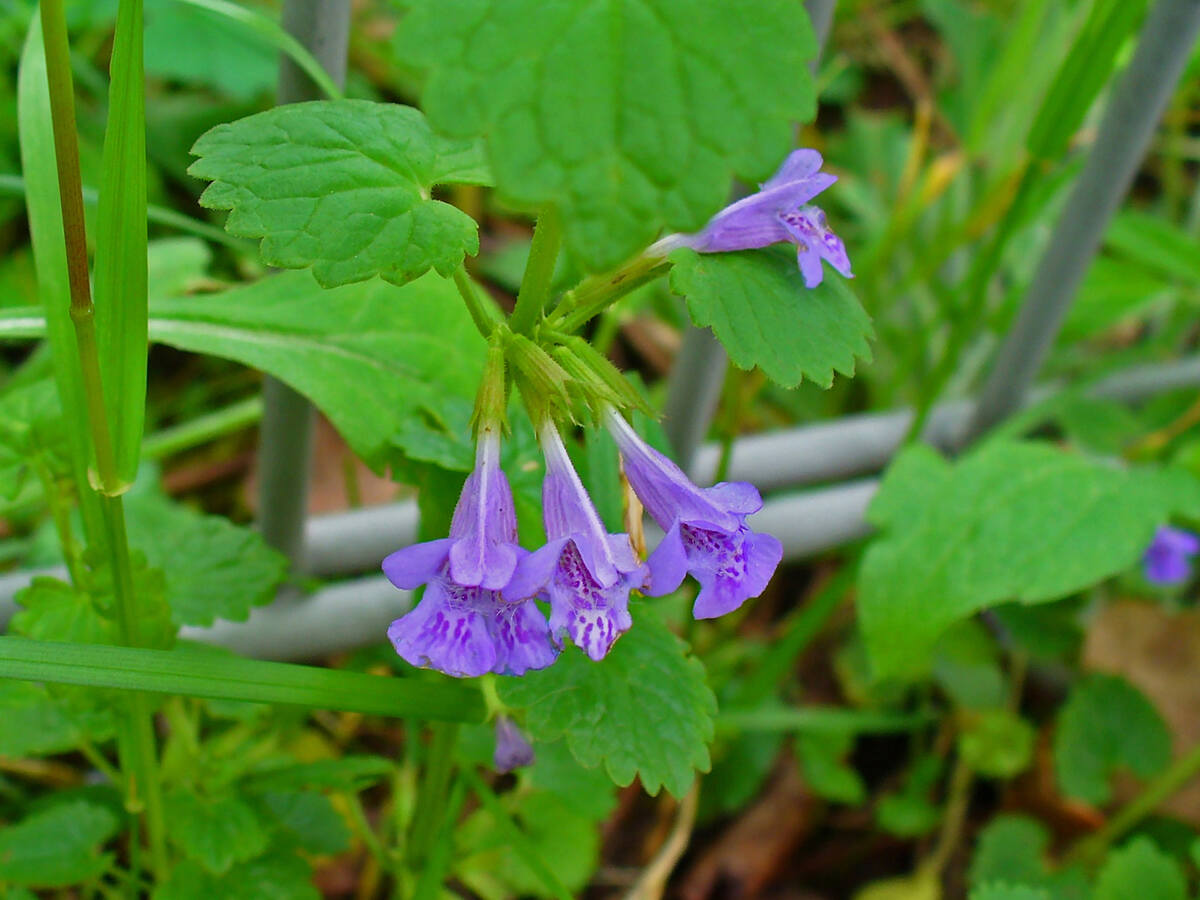
Lubbock’s fertile soil not only supports cotton crops but also pesky weeds. Effective weed control in Lubbock, which includes optimizing soil nutrients and water inputs, is essential for maintaining a healthy green lawn.
Fortunately, you’re in the right place. In this article, we’ll explore how to identify common weeds and how to eliminate them from your landscape, ensuring your yard is in championship form — worthy of hosting the Texas Tech Red Raiders.
Common Broadleaf Weeds in Lubbock
Broadleaf weeds are a diverse group of plants characterized by their wide leaves (hence the name), each featuring a prominent central vein. These weeds are varied in appearance and in their root structures: Some have a fibrous root system anchored by a large primary taproot, while others may possess a network of thinner roots.
This variety in both foliage and root systems makes broadleaf weeds particularly resilient and adaptable to different environments, posing a challenge for gardeners and homeowners in Lubbock.
1. Dandelion (Taraxacum officinale)
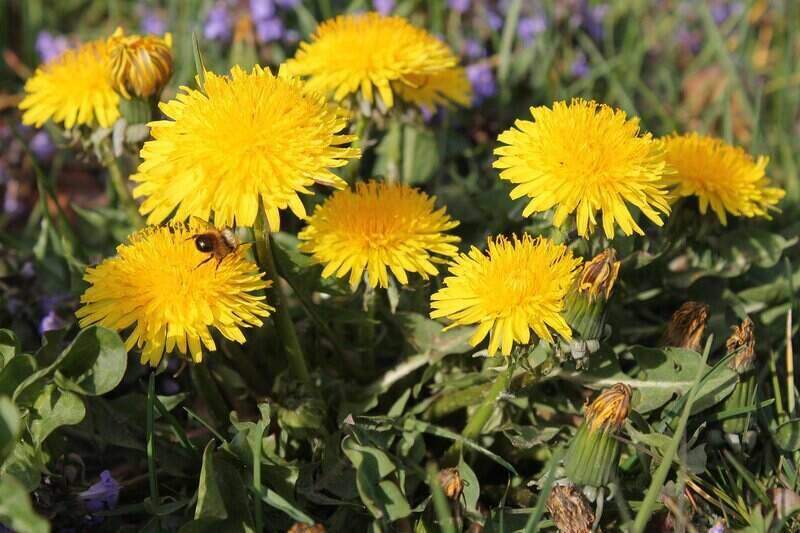
The dandelion is one of the most pervasive weeds found throughout the U.S., and that includes Texas. They thrive best in sunny, moist areas, but don’t be fooled — these weeds can adapt to less-than-ideal conditions too.
One of the trickiest aspects of controlling dandelions lies in their strong taproot. It allows dandelions to bounce back even if the plant is cut off above ground. In fact, leaving just an inch of the root in the soil can lead to a comeback, which is why it’s crucial to remove every bit.
- Life cycle: Winter perennial
- Weed type: Broadleaf
- Where it thrives: Wide variety of soils, but prefers soils with low calcium and high levels of nitrogen and potassium. Can indicate acidic soil conditions.
- How to identify dandelion: Bright yellow flowers that bloom in April. Produces a seed head in the form of a puffball. Long serrated leaves that point back to the center of the rosette.
- How to get rid of dandelion: Dig out as much of the taproot as possible in early spring. You can combine the treatment with a spring pre-emergent herbicide application to avoid the establishment of new weeds since dandelions can regenerate from fragments of roots. You can also use a broadleaf post-emergent herbicide during fall, which is generally more effective on perennials.
2. White Clover (Trifolium repens)
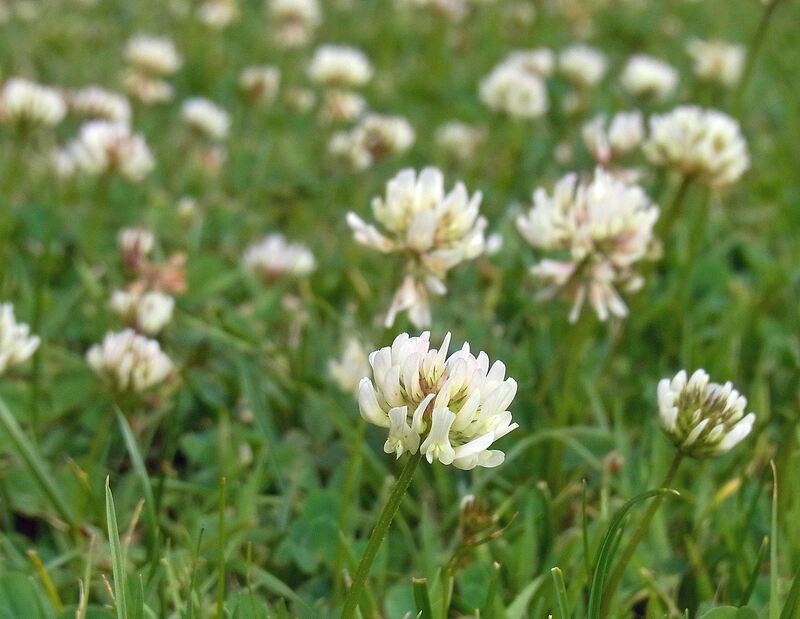
White clover, known for its distinctive trio of leaflets, can be a nuisance in lawns seeking a uniform green appearance. However, despite its reputation as an unwanted weed, there’s a growing appreciation for clover lawns due to their low-maintenance qualities and environmental benefits. (They fix nitrogen in the soil.)
- Life cycle: Perennial
- Weed type: Broadleaf
- Where it thrives: Dry, compacted, acidic soils with low nitrogen levels.
- How to identify clover: It has three green leaflets. Flowers are a cluster of white or pink blooms. It forms a mat.
- How to get rid of clover: Hand-pull small patches of clover, making sure you remove the entire root system. Soak the area the night before to loosen the soil and make this task easier. You can also spot-treat with post-emergent herbicides or with vinegar (mix one cup of vinegar with one cup of water and apply the mixture every day).
3. Ground Ivy (Glechoma hederacea)
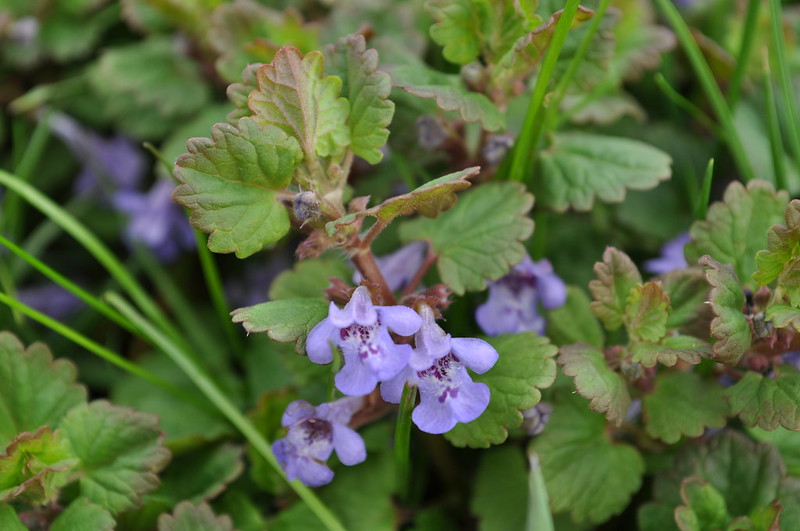
Ground ivy, also known as creeping Charlie, is a formidable adversary in your lawn due to its rapid spread and resilient nature. Identifying and tackling this weed when it is still young is key, as this plant propagates through seeds, roots, and even stem fragments. It can quickly overtake lawns and garden beds.
- Life cycle: Perennial
- Weed type: Broadleaf
- Where it thrives: Shady areas with moist soil
- How to identify ground ivy: It has a creeping growth and small purple flowers. The leaves are heart-shaped and opposite to each other, with scalloped edges. They give a minty fragrance when crushed.
- How to get rid of ground ivy: Small sections can be removed by hand or with a rake, but larger invasions may require post-emergent herbicides containing glyphosate to get rid of them. (Before you spray, read up on the Pros, Cons, and Alternatives to Glyphosate.)
4. Spotted Spurge (Euphorbia maculata)
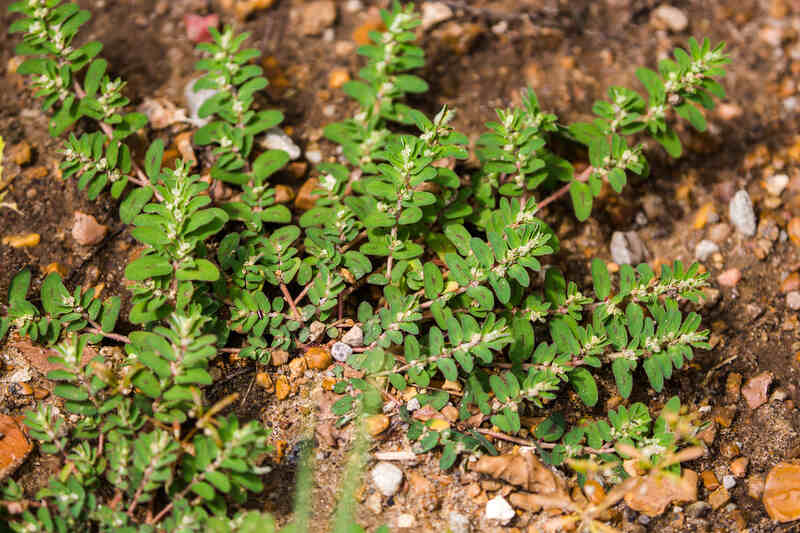
Spotted spurge is a hardy weed that can thrive in the most challenging of places, including the tiny cracks in sidewalks. The weed grows rapidly, forming a dense, low-lying mat that radiates outward from a central taproot. When dealing with spotted spurge, wear gloves since the plant produces a milky sap that can irritate the skin.
- Life cycle: Summer annual
- Weed type: Broadleaf
- Where it thrives: Prefers full sun and warm temperatures. Grows in various soil types: loam, sand, clay, and rocky soils.
- How to identify spotted spurge: Leaves have a distinguishing brown spot in the center. When stems break, a milky sap is released.
- How to get rid of spotted spurge: Easy to remove a few large plants by hand since they grow from a single taproot. Because it produces abundant seeds and has no seed dormancy, it spreads easily. The best option is to prevent it by improving turf density in the fall and spring through overseeding.
5. Bittercress (Cardamine hirsuta)
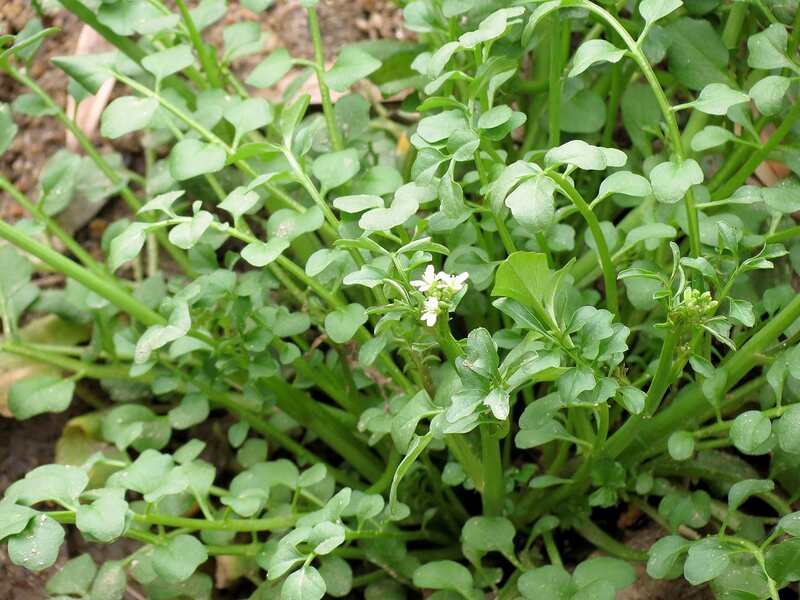
Also known as hairy bittercress, this weed is identifiable by the small hairs found at the base of its leaves and along the leaf surface. It also produces delicate small white flowers. While bittercress is not particularly difficult to control, it can swiftly invade areas where the turf is thin and the soil moisture is high.
- Life cycle: Winter or summer annual
- Weed type: Broadleaf
- Where it thrives: Most environments. Prefers moisture.
- How to identify bittercress: It is a low-growing weed with a basal rosette. Pairs of two to four leaflets are arranged alternately on the leaf stems. It’s possible to find small hairs at the base of the leaf.
- How to get rid of bittercress: Mow frequently during spring to remove flower stems. Don’t let it go to seed. This weed is easy to pull or dig up. Pre and post-emergent herbicides also work.
6. Henbit (Lamium amplexicaule)
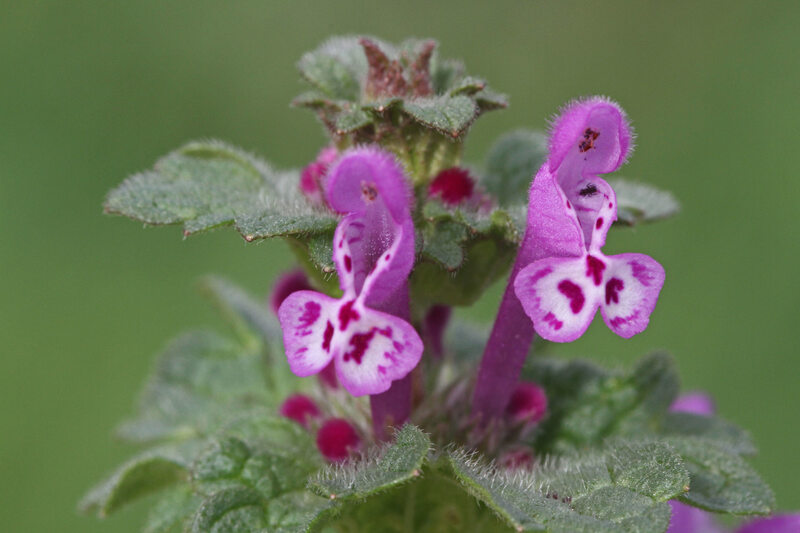
Henbit earned its name due to its popularity as a snack among chickens. A member of the mint family, henbit can often be mistaken for ground ivy. It features a fibrous root system that makes hand weeding less effective. Post-emergent herbicides containing glyphosate and oxyfluorfen are often used for more thorough control.
- Life cycle: Winter annual
- Weed type: Broadleaf
- Where it thrives: Fertile soil, but will also grow in sandy soils. Prefers full to partial shade, but tolerates sun.
- How to identify henbit: Hairy and rounded leaves with deep veins. Square stems. It blooms with small pink to purple flowers.
- How to get rid of henbit: This weed’s seedlings are easy to control with pre-emergent herbicides applied in early to mid-September. If the treatment window for pre-emergent application is missed, homeowners can control henbit with post-emergent herbicides in early November. Two to four applications might be needed.
Common Grassy Weeds in Lubbock
Grassy weeds closely mimic the appearance of lawn grass, which often makes them difficult to identify and manage. These weeds are characterized by their long, narrow leaves with parallel veins running the length of each blade. The leaves typically alternate on each side of the stem.
1. Crabgrass (Digitaria ischaemum)
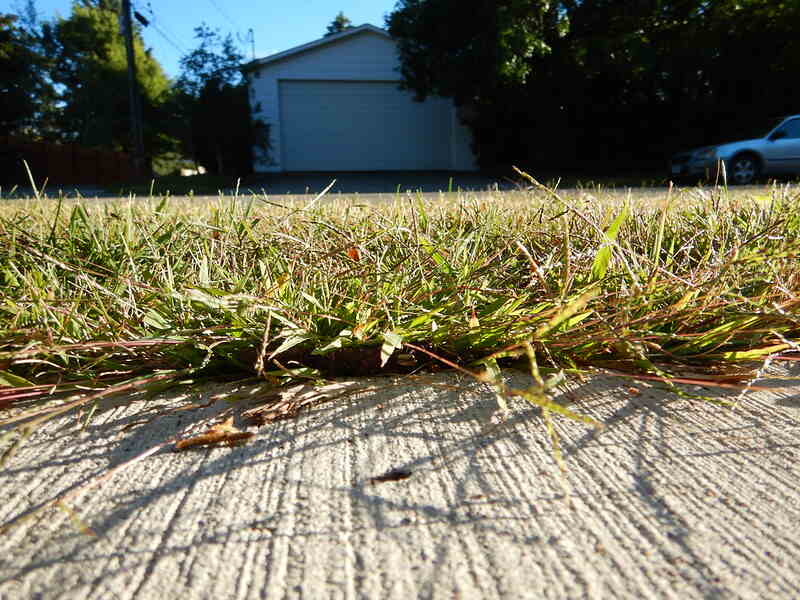
Crabgrass is often cited as the number one challenge in lawn care, notorious for its vast seed bank and rapid growth rate. The best strategy for managing this weed is prevention. Establishing a dense, healthy lawn is key: Thick turf prevents crabgrass seeds from getting the sunlight they need to germinate.
Maintaining your Lubbock lawn through proper mowing, watering, and fertilizing creates a robust grass cover that resists the invasion of crabgrass and other weeds.
- Life cycle: Summer annual
- Weed type: Grass
- Where it thrives: Heavier soil types but tolerates a variety of conditions: heat, drought, full sun, and partial shade. It is killed by frost. It can also be indicative of excess nitrogen in your lawn.
- How to identify crabgrass: Light green colored, this weed has noticeable nodes from which the leaves grow in a zig-zag pattern. It has a coarse texture.
- How to get rid of crabgrass: Mowing your lawn higher and fertilizing it with nitrogen will increase the crabgrass’s competition. Mulching can also slow the germination process. The plant hugs the ground as it grows, making it hard to hand pull once established.
2. Yellow Foxtail (Setaria glauca)
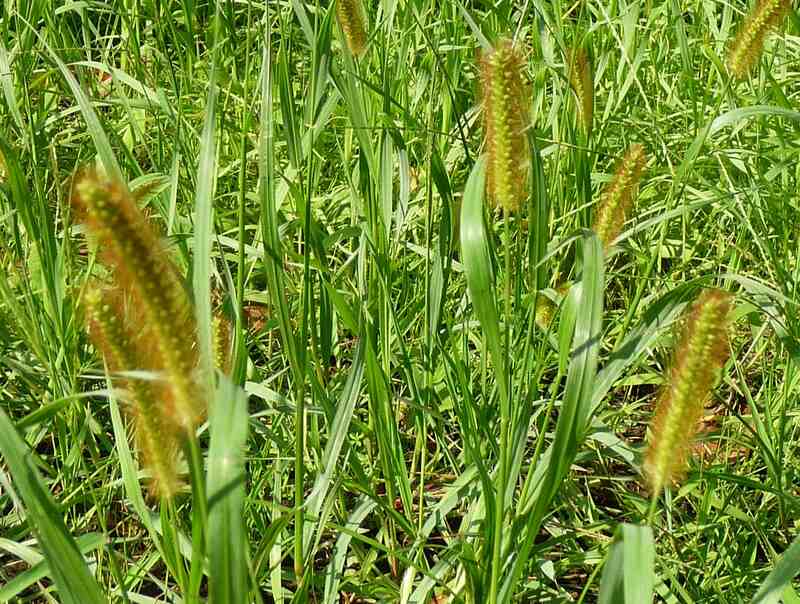
Yellow foxtail is not only a visual nuisance in lawns and gardens but also a physical hazard. This weed has sharp, bristly seeds that can penetrate the skin, posing a risk to you, your children, and pets who enjoy spending time outdoors. Beyond that, yellow foxtail aggressively competes for nutrients, space, and sunlight with grass, plants, and trees.
- Life cycle: Annual
- Weed type: Grass
- Where it thrives: It is best adapted to sunny areas but can tolerate a wide range of environments, including dry or moist soils. It also tolerates drought conditions.
- How to identify foxtail: It has coarse leaves that are pale to medium green. A fringe of short, fine hairs work as a ligule. When mature, seedheads have a yellow-green tinge.
- How to get rid of foxtail: If there are only a few plants in your lawn, hand-pulling might be enough. This weed can also be controlled with pre-emergent and post-emergent herbicides. Make sure to follow label instructions.
3. Annual Bluegrass (Poa annua)
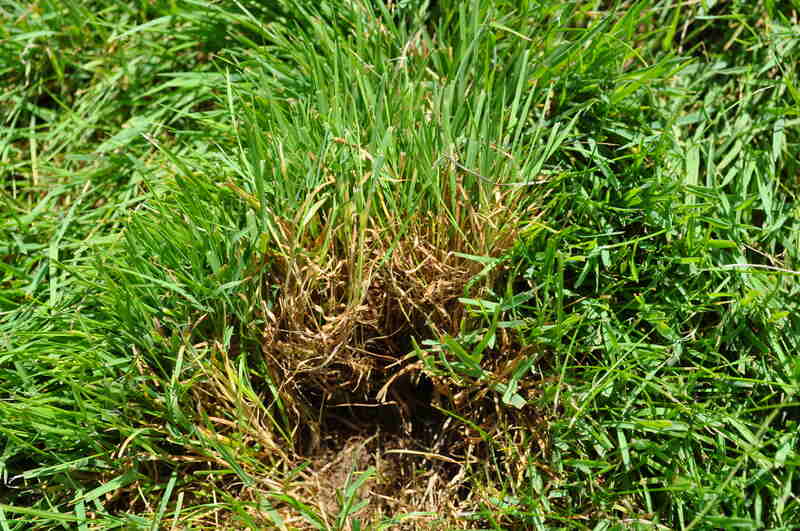
Annual bluegrass might seem unassuming, but don’t let its appearance fool you. This weed is known for its ability to produce hundreds of viable seeds, even when kept short by frequent mowing. You can spot annual bluegrass by its telltale seed heads, which stick out above the rest of your lawn.
While completely eliminating this weed is practically impossible, a smart approach is to use pre-emergent herbicides in the fall. These prevent seeds from sprouting and will help control annual bluegrass.
- Life cycle: Winter annual
- Weed type: Grass
- Where it thrives: Prefers moist soils and shady areas.
- How to identify annual bluegrass: The leaves are yellow-green colored, and whitish flowers distinguish this grass. It has a coarse texture.
- How to get rid of annual bluegrass: The main method of managing it is removing small plants to avoid further infestation. It can lay dormant for years before sprouting, so if you spot plants in your yard after removing it, apply a pre-emergent herbicide to prevent further seeds from germinating. Fertilizing your soil will also help prevent this weed.
4. Dallisgrass (Paspalum dilatatum)
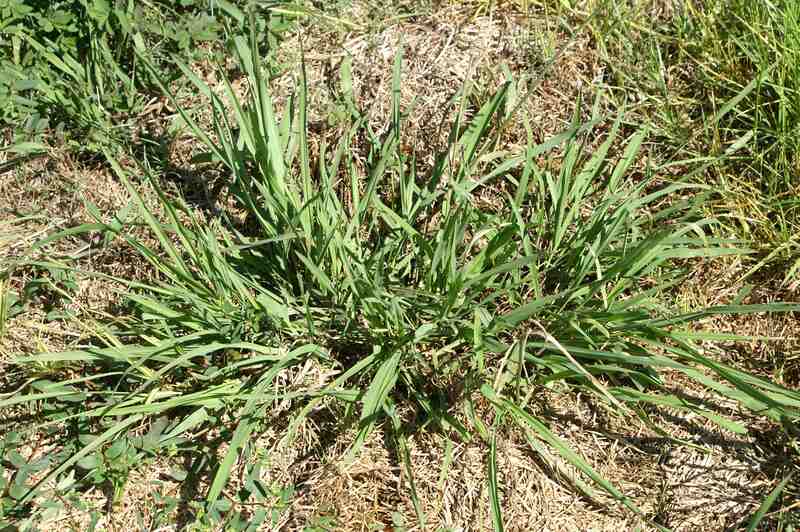
Dallisgrass can be a real eyesore in your Lubbock lawn due to its unattractive clumping growth pattern and coarse texture. This weed is notoriously difficult to manage once it has taken hold. To make matters worse, it thrives in nitrogen-rich soil, so regular fertilizing intended to nourish your lawn might inadvertently bolster its growth instead.
- Life cycle: Perennial
- Weed type: Grass
- Where it thrives: Moist conditions, such as heavily irrigated areas. It grows in full sun and partial shade.
- How to identify dallisgrass: It has a mid-rib that differentiates it from other grass-like weeds. The seed heads are easily identifiable as well: a raceme with hairy spikelets.
- How to get rid of dallisgrass: The biggest step is preventing dallisgrass from establishing. Dig out young plants and apply pre-emergent herbicide to avoid future growth. You can also spot-treat the site with a post-emergent herbicide.
5. Yellow Nutsedge (Cyperus esculentus)
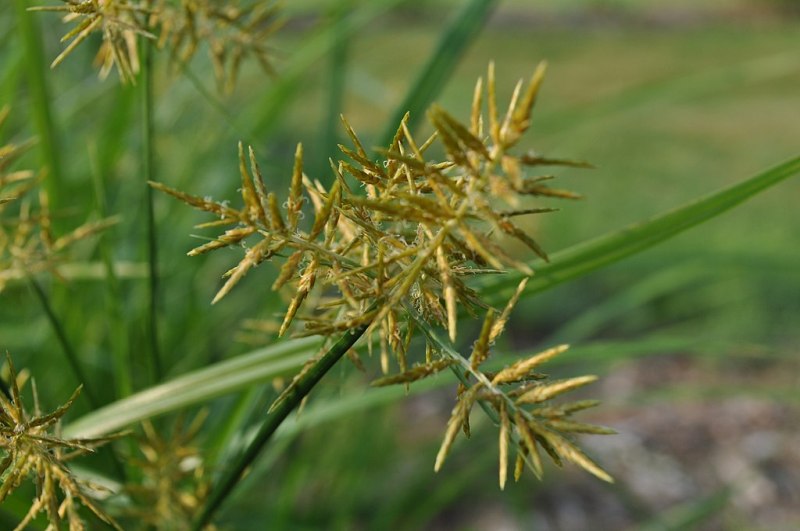
Yellow nutsedge is an aggressive weed that poses problems for lawns and also for agricultural crops. This weed is difficult to manage due to an underground system of tubers, which can regenerate quickly. Combining lawn care practices with chemical and mechanical control methods is often necessary to control nutsedge.
- Life cycle: Perennial
- Weed type: Sedge
- Where it thrives: Wet areas with full sun exposure but can adapt to various conditions. It is often an indicator of excess watering or poor soil drainage.
- How to identify nutsedge: Long, light green or yellow leaves with a glossy appearance. As typically found in sedges, a triangular stem is a key feature when differentiating from other grassy weeds. The flowers bloom at the end of the branches in the form of yellow spikelets.
- How to get rid of nutsedge: Nutsedge can be hand-pulled, but be sure to remove all underground tubers and rhizomes. This weed type is best controlled with post-emergent herbicide applications. Selective herbicides are effective only when applied on actively growing plants.
How to Prevent Weeds in Lubbock
Every weed has its quirks, but most agree on one thing: They love the less-than-ideal conditions of a struggling lawn. Thinning grass, poor soil, and inconsistent watering are prime real estate for weeds looking for a place to grow. Here’s how you can discourage weeds from settling down in your Lubbock lawn and garden:
- Feed your lawn with the nutrients it needs so your grass can grow thick and robust, outcompeting weeds.
- Water your lawn infrequently and deeply to encourage deeper root growth, which helps the lawn resist drought and weeds.
- Apply pre-emergent herbicides to prevent weed seeds from germinating.
- Keep your lawn mower blade set higher to leave the grass longer. Taller grass strengthens the turf and shades the soil, preventing weed seeds from getting the sunlight they need.
- Apply a thick layer of mulch to flower and garden beds. Mulch helps retain soil moisture and block light from reaching weed seeds.
Weed Control Services in Lubbock
When it comes to professional weed control services, costs can vary based on several factors. For a standard quarter-acre lot, the average cost for weed control is around $100. However, prices can range from $65 to $165, depending on the specific methods and types of herbicides used.
If you own a larger property, expect higher costs for weed control services. Additionally, prices may vary slightly by location within the Lubbock area. Consider connecting with a local lawn care pro to get a quote.
Pro tip: City regulations in Lubbock stipulate that allowing weeds to grow over 8 feet tall is a violation, subjecting property owners to a potential Notice of Violation. So, proactive weed control is more than just good practice in Hub City; it’s to ensure you remain on the right side of the law.
FAQ About Lubbock Weed Control
When Should I Treat My Lawn for Weeds in Texas?
The best time to apply pre-emergent herbicides, which are designed to prevent weeds from germinating, is in the spring. Aim to apply when the soil temperatures reach between 50 and 55 degrees Fahrenheit. A second application can be made in the fall, when soil temperatures drop back down to around 70 F.
However, you may also have to deal with weeds after a rainy season, which is rare in Lubbock, but will encourage weed growth, like it did in 2023. During these times, you can apply post-emergent herbicides. They are effective at killing weeds that have already sprouted, helping you regain control of your lawn quickly.
What is the Best Grass for Lubbock, Texas?
The best grass for Lubbock depends largely on your specific needs and preferences for a lawn. Bermudagrass is the most commonly used turfgrass in the Hub City due to its durability. Other grasses like buffalograss, Zoysia, and tall fescue are also used.
If you want to have healthy grass in Lubbock, it’s important to implement smart watering practices that conserve water but also ensure your lawn receives enough moisture to thrive. In addition, Lubbock’s frequent dust storms can cover your lawn with dust. So, you’ll need to use a leaf blower to clear it away, particularly from turf that doesn’t tolerate shade, like Bermuda.
When Should I Fertilize My Lawn in Texas?
The timing of fertilizing your lawn in Texas largely depends on the type of grass you have. For warm-season grasses, which include Bermuda, Zoysia, and buffalograss, the best time to apply fertilizer is in spring. If you have cool-season grass like tall fescue, the best time to fertilize is in September.
When to Call a Pro
Maintaining a weed-free lawn in Lubbock requires choosing the right strategies to address them. If you find yourself overwhelmed by the intricacies of lawn care and just want to relax while listening to Buddy Holly’s tunes, don’t hesitate to reach out to a local lawn care professional for help. They can provide tailored solutions to ensure your lawn survives and thrives.
Main Image Credit: H. Zell / Wikimedia Commons / CC BY-SA 3.0